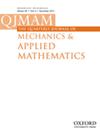Image Conditions for Spherical-Coordinate Separation-of-Variables Acoustic Multiple Scattering Models with Perfectly-Reflecting Flat Surfaces
IF 0.8
4区 工程技术
Q3 MATHEMATICS, APPLIED
Quarterly Journal of Mechanics and Applied Mathematics
Pub Date : 2017-11-01
DOI:10.1093/QJMAM/HBX018
引用次数: 3
Abstract
Efficient implementation of the method of images is addressed for 3D multiple scattering models (MSM) for spheres with perfectly-reflecting flat surfaces. The Helmholtz equation is solved by the spherical-coordinate separation-of-variables approach and addition theorems for spherical wavefunctions. The unknown coefficients of outgoing waves from image objects are related with those of real counterparts through ‘image conditions’ which are derived in this article. The method of images is applied to concave part of wedge-shaped acoustic domains with apex angles of π/n rad for a positive integer n, which includes half-space and corners. Image conditions make the MSM numerically more efficient: memory space is reduced by 4n2 times; matrix is populated 2n- times faster for infinite or 2D wedges. Savings are 16n2 times in memory and 4n times in speed for semi-infinite or 3D wedges. Image conditions are valid regardless of the type of scatterers as long as they are spheres and submerged in acoustic domains; they are also suitable for the modified Helmholtz equation and radiation problems. However, specific formulae of image conditions depend on definitions of the spherical harmonics. Image conditions for rigid flat surfaces are verified by measurements of 13 balls in an anechoic chamber for configurations of half-space, 2D & 3D corners and 3D wedge with n=3. Image conditions for pressure-release flat interfaces are validated by the boundary element method (BEM) for the pulsation mode of an underwater air sphere in half-space and for scattering by a sphere in an ocean environment with the wedge angle of 1.2° by n=150. Agreement is very good between the MSM and measurements and is impeccable between the MSM and BEM.具有完全反射平面的球坐标变量分离声学多重散射模型的成像条件
针对具有完美反射平面的球体的三维多重散射模型(MSM),研究了图像方法的有效实现。采用球坐标分离变量法和球面波函数的加法定理求解了亥姆霍兹方程。通过导出的“图像条件”,将图像对象的出射波的未知系数与真实对象的未知系数联系起来。将图像方法应用于顶点角为π/n rad的正整数n的楔形声域的凹部,其中包括半空间和角。图像条件使MSM在数值上更有效:内存空间减少了4n2倍;矩阵的填充速度是无限或二维楔形的2n倍。对于半无限或3D楔形,可以节省16n2倍的内存和4n倍的速度。无论散射体的类型如何,只要它们是球体并淹没在声域中,图像条件都是有效的;它们也适用于修正亥姆霍兹方程和辐射问题。然而,图像条件的具体公式取决于球面谐波的定义。通过在消声室中测量13个球的半空间、二维和三维角以及n=3的三维楔形结构,验证了刚性平面的成像条件。利用边界元法(BEM)验证了压力释放平面界面的成像条件,并对半空间水下空气球的脉动模式和海洋环境中楔角为1.2°× n=150的球体散射进行了验证。MSM和测量值之间的一致性非常好,MSM和BEM之间的一致性无可挑剔。
本文章由计算机程序翻译,如有差异,请以英文原文为准。
求助全文
约1分钟内获得全文
求助全文
来源期刊
CiteScore
1.90
自引率
11.10%
发文量
14
审稿时长
>12 weeks
期刊介绍:
The Quarterly Journal of Mechanics and Applied Mathematics publishes original research articles on the application of mathematics to the field of mechanics interpreted in its widest sense. In addition to traditional areas, such as fluid and solid mechanics, the editors welcome submissions relating to any modern and emerging areas of applied mathematics.

 求助内容:
求助内容: 应助结果提醒方式:
应助结果提醒方式:


